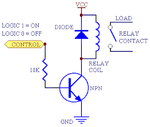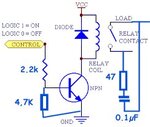burrow
Full Member level 2
Hai,
iam on a project using PIC MCU's, its in the final stage now. But i noticed a really weird problem. Everything is working really fine except one. on receiving some signals the MCU turns on a relay.
MCU drives BC547 transistors's base, the relay is connected to this transistor.
The relay turns on fine when it receives signal. But when the relay turns OFF everything starts going wrong.. My LCD display starts blinking rapidly and MCU starts heating. Everything gets back to normal after a restart.
What might be wrong ?
iam on a project using PIC MCU's, its in the final stage now. But i noticed a really weird problem. Everything is working really fine except one. on receiving some signals the MCU turns on a relay.
MCU drives BC547 transistors's base, the relay is connected to this transistor.
The relay turns on fine when it receives signal. But when the relay turns OFF everything starts going wrong.. My LCD display starts blinking rapidly and MCU starts heating. Everything gets back to normal after a restart.
What might be wrong ?

